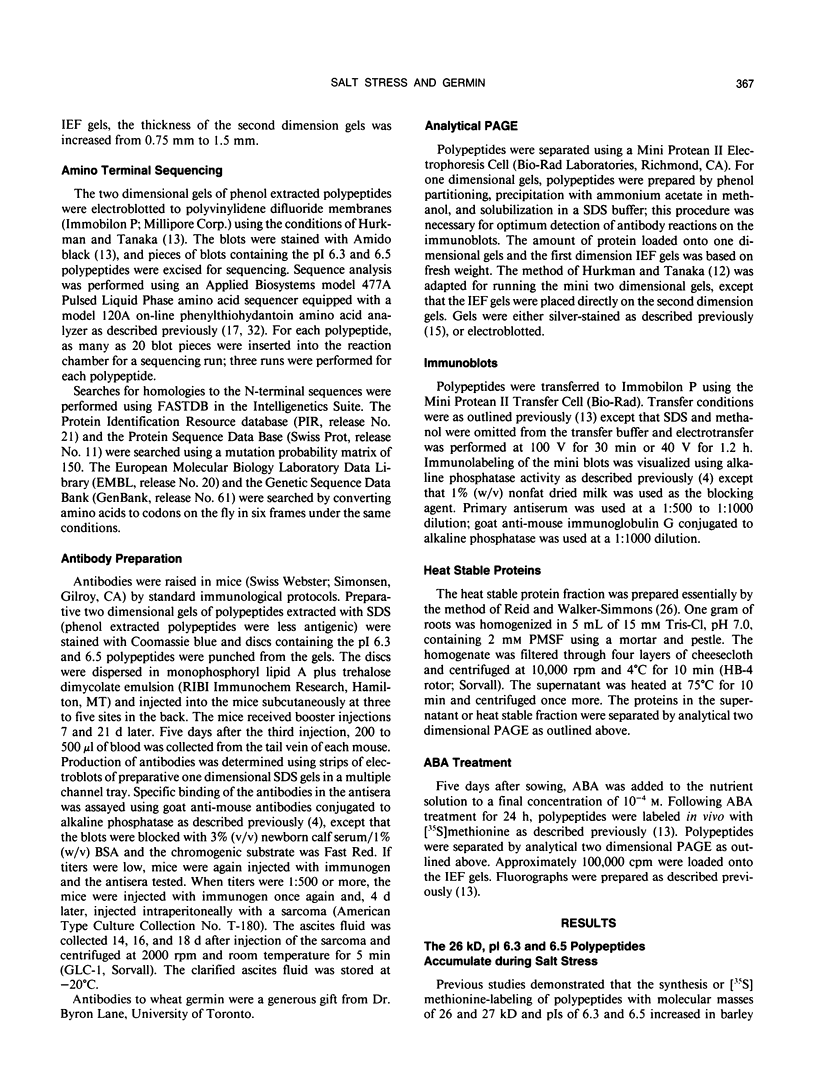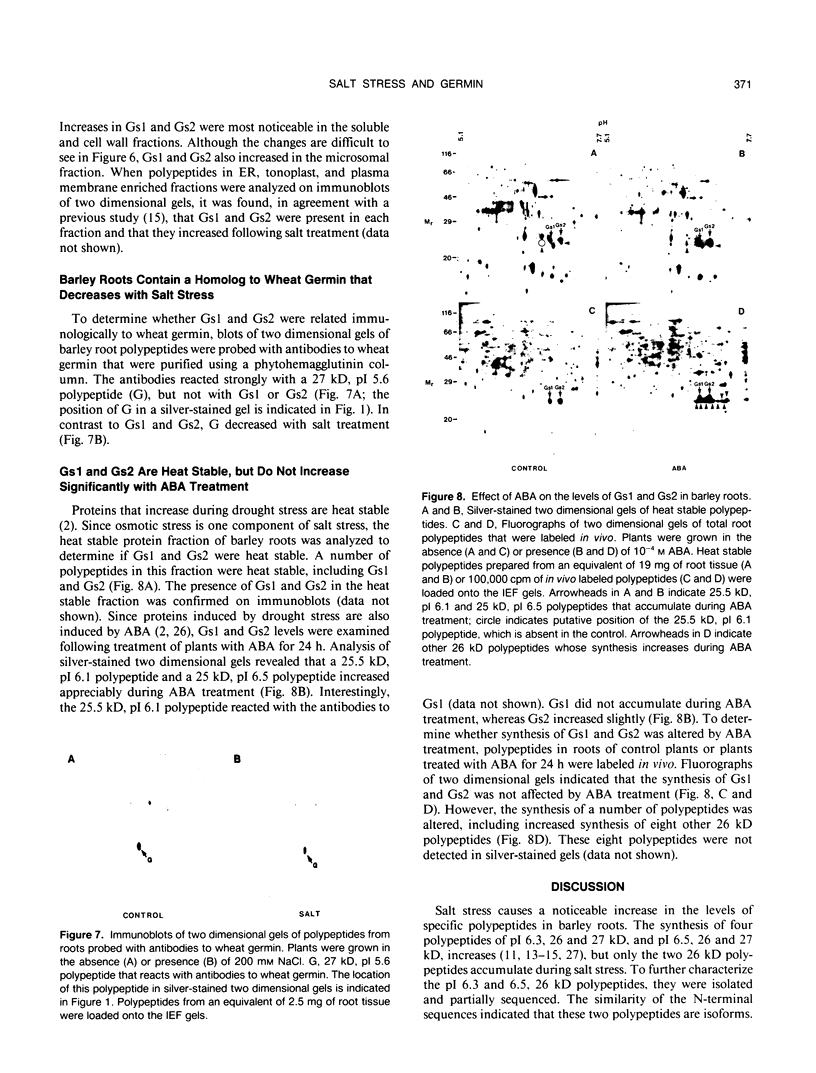Abstract
The 26 kilodalton, isoelectric point 6.3 and 6.5 (Gs1 and Gs2) polypeptides that increase in barley (Hordeum vulgare L.) roots during salt stress were isolated and identified. Both Gs1 and Gs2 had high sequence similarity to germin, a protein that increases significantly in germinating wheat seeds. Like germin, Gs1 and Gs2 were resistant to proteases and were glycosylated. Immunoblots were probed with antibodies to Gs1 and Gs2 to determine the distribution of these polypeptides among organs and cell-free fractions. Gs1 and Gs2 were present in roots and coleoptiles, but absent from leaves. In roots, Gs1 and Gs2 were present in the mature region, but not the tip. Gs1 and Gs2 increased in roots, but decreased in coleoptiles in response to salt stress. Gs1 and Gs2 were distributed among the soluble, microsomal, and cell wall fractions of roots, but the majority of Gs1 and Gs2 was present in the soluble fraction. Although Gs1 and Gs2 were heat stable, their synthesis was not affected by abscisic acid treatment. Gs2 accumulated during abscisic acid treatment, whereas Gs1 did not. However, a 25.5 kilodalton, isoelectric point 6.1 polypeptide that was immunologically related to Gs1 did accumulate with abscisic acid treatment.
Full text
PDF








Images in this article
Selected References
These references are in PubMed. This may not be the complete list of references from this article.
- Claes B., Dekeyser R., Villarroel R., Van den Bulcke M., Bauw G., Van Montagu M., Caplan A. Characterization of a rice gene showing organ-specific expression in response to salt stress and drought. Plant Cell. 1990 Jan;2(1):19–27. doi: 10.1105/tpc.2.1.19. [DOI] [PMC free article] [PubMed] [Google Scholar]
- Close T. J., Kortt A. A., Chandler P. M. A cDNA-based comparison of dehydration-induced proteins (dehydrins) in barley and corn. Plant Mol Biol. 1989 Jul;13(1):95–108. doi: 10.1007/BF00027338. [DOI] [PubMed] [Google Scholar]
- Dratewka-Kos E., Rahman S., Grzelczak Z. F., Kennedy T. D., Murray R. K., Lane B. G. Polypeptide structure of germin as deduced from cDNA sequencing. J Biol Chem. 1989 Mar 25;264(9):4896–4900. [PubMed] [Google Scholar]
- Dupont F. M., Tanaka C. K., Hurkman W. J. separation and Immunological Characterization of Membrane Fractions from Barley Roots. Plant Physiol. 1988 Mar;86(3):717–724. doi: 10.1104/pp.86.3.717. [DOI] [PMC free article] [PubMed] [Google Scholar]
- Faye L., Chrispeels M. J. Characterization of N-linked oligosaccharides by affinoblotting with concanavalin A-peroxidase and treatment of the blots with glycosidases. Anal Biochem. 1985 Aug 15;149(1):218–224. doi: 10.1016/0003-2697(85)90498-1. [DOI] [PubMed] [Google Scholar]
- Grzelczak Z. F., Sattolo M. H., Hanley-Bowdoin L. K., Kennedy T. D., Lane B. G. Synthesis and turnover of proteins and mRNA in germinating wheat embryos. Can J Biochem. 1982 Mar;60(3):389–397. doi: 10.1139/o82-046. [DOI] [PubMed] [Google Scholar]
- Hurkman W. J., Fornari C. S., Tanaka C. K. A Comparison of the Effect of Salt on Polypeptides and Translatable mRNAs in Roots of a Salt-Tolerant and a Salt-Sensitive Cultivar of Barley. Plant Physiol. 1989 Aug;90(4):1444–1456. doi: 10.1104/pp.90.4.1444. [DOI] [PMC free article] [PubMed] [Google Scholar]
- Hurkman W. J., Tanaka C. K., Dupont F. M. The effects of salt stress on polypeptides in membrane fractions from barley roots. Plant Physiol. 1988 Dec;88(4):1263–1273. doi: 10.1104/pp.88.4.1263. [DOI] [PMC free article] [PubMed] [Google Scholar]
- Hurkman W. J., Tanaka C. K. Polypeptide changes induced by salt stress, water deficit, and osmotic stress in barley roots: a comparison using two-dimensional gel electrophoresis. Electrophoresis. 1988 Nov;9(11):781–787. doi: 10.1002/elps.1150091114. [DOI] [PubMed] [Google Scholar]
- Hurkman W. J., Tanaka C. K. Solubilization of plant membrane proteins for analysis by two-dimensional gel electrophoresis. Plant Physiol. 1986 Jul;81(3):802–806. doi: 10.1104/pp.81.3.802. [DOI] [PMC free article] [PubMed] [Google Scholar]
- Hurkman W. J., Tanaka C. K. The effects of salt on the pattern of protein synthesis in barley roots. Plant Physiol. 1987 Mar;83(3):517–524. doi: 10.1104/pp.83.3.517. [DOI] [PMC free article] [PubMed] [Google Scholar]
- Jaikaran A. S., Kennedy T. D., Dratewka-Kos E., Lane B. G. Covalently bonded and adventitious glycans in germin. J Biol Chem. 1990 Jul 25;265(21):12503–12512. [PubMed] [Google Scholar]
- Juneau M., Johnstone M., Dempsey E., Waters D. D. Exercise-induced myocardial ischemia in a cold environment. Effect of antianginal medications. Circulation. 1989 May;79(5):1015–1020. doi: 10.1161/01.cir.79.5.1015. [DOI] [PubMed] [Google Scholar]
- LOWRY O. H., ROSEBROUGH N. J., FARR A. L., RANDALL R. J. Protein measurement with the Folin phenol reagent. J Biol Chem. 1951 Nov;193(1):265–275. [PubMed] [Google Scholar]
- Morris P. C., Kumar A., Bowles D. J., Cuming A. C. Osmotic stress and abscisic acid induce expression of the wheat Em genes. Eur J Biochem. 1990 Jul 5;190(3):625–630. doi: 10.1111/j.1432-1033.1990.tb15618.x. [DOI] [PubMed] [Google Scholar]
- Mundy J., Chua N. H. Abscisic acid and water-stress induce the expression of a novel rice gene. EMBO J. 1988 Aug;7(8):2279–2286. doi: 10.1002/j.1460-2075.1988.tb03070.x. [DOI] [PMC free article] [PubMed] [Google Scholar]
- Ostrem J. A., Olson S. W., Schmitt J. M., Bohnert H. J. Salt Stress Increases the Level of Translatable mRNA for Phosphoenolpyruvate Carboxylase in Mesembryanthemum crystallinum. Plant Physiol. 1987 Aug;84(4):1270–1275. doi: 10.1104/pp.84.4.1270. [DOI] [PMC free article] [PubMed] [Google Scholar]
- Ried J. L., Walker-Simmons M. K. Synthesis of abscisic Acid-responsive, heat-stable proteins in embryonic axes of dormant wheat grain. Plant Physiol. 1990 Jun;93(2):662–667. doi: 10.1104/pp.93.2.662. [DOI] [PMC free article] [PubMed] [Google Scholar]
- Singh N. K., Bracker C. A., Hasegawa P. M., Handa A. K., Buckel S., Hermodson M. A., Pfankoch E., Regnier F. E., Bressan R. A. Characterization of osmotin : a thaumatin-like protein associated with osmotic adaptation in plant cells. Plant Physiol. 1987 Oct;85(2):529–536. doi: 10.1104/pp.85.2.529. [DOI] [PMC free article] [PubMed] [Google Scholar]
- Singh N. K., Handa A. K., Hasegawa P. M., Bressan R. A. Proteins Associated with Adaptation of Cultured Tobacco Cells to NaCl. Plant Physiol. 1985 Sep;79(1):126–137. doi: 10.1104/pp.79.1.126. [DOI] [PMC free article] [PubMed] [Google Scholar]
- Singh N. K., Larosa P. C., Handa A. K., Hasegawa P. M., Bressan R. A. Hormonal regulation of protein synthesis associated with salt tolerance in plant cells. Proc Natl Acad Sci U S A. 1987 Feb;84(3):739–743. doi: 10.1073/pnas.84.3.739. [DOI] [PMC free article] [PubMed] [Google Scholar]
- Singh N. K., Nelson D. E., Kuhn D., Hasegawa P. M., Bressan R. A. Molecular Cloning of Osmotin and Regulation of Its Expression by ABA and Adaptation to Low Water Potential. Plant Physiol. 1989 Jul;90(3):1096–1101. doi: 10.1104/pp.90.3.1096. [DOI] [PMC free article] [PubMed] [Google Scholar]
- Thompson E. W., Lane B. G. Relation of protein synthesis in imbibing wheat embryos to the cell-free translational capacities of bulk mRNA from dry and imbibing embryos. J Biol Chem. 1980 Jun 25;255(12):5965–5970. [PubMed] [Google Scholar]
- Towbin H., Staehelin T., Gordon J. Electrophoretic transfer of proteins from polyacrylamide gels to nitrocellulose sheets: procedure and some applications. Proc Natl Acad Sci U S A. 1979 Sep;76(9):4350–4354. doi: 10.1073/pnas.76.9.4350. [DOI] [PMC free article] [PubMed] [Google Scholar]
- White J. A., Scandalios J. G. Isolation and characterization of a cDNA for mitochondrial manganese superoxide dismutase (SOD-3) of maize and its relation to other manganese superoxide dismutases. Biochim Biophys Acta. 1988 Nov 10;951(1):61–70. doi: 10.1016/0167-4781(88)90025-5. [DOI] [PubMed] [Google Scholar]









